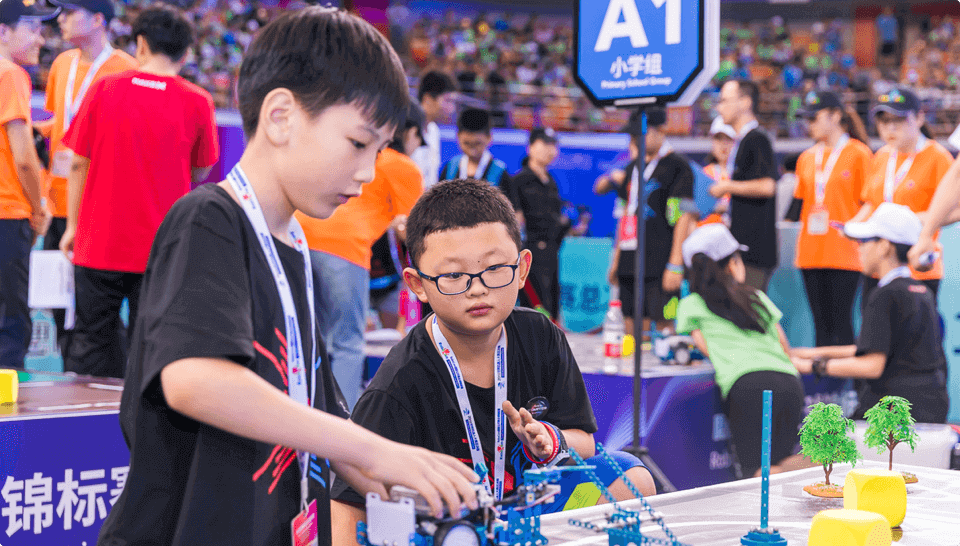Mar 15, 2024 | Makeblock
From the awe-inspiring heights of aeronautics to the microscopic precision of nanotechnology, engineers harness the power of mathematical and scientific principles to revolutionize industries and enhance our daily lives. The design of a commercial jetliner that connects the globe and the convenience of a household appliance that simplifies meal preparation are both testaments to the ingenuity of engineering.
As we navigate the complex and interconnected world of engineering, it becomes evident that certain disciplines, mechanical and electrical engineering in particular, are inextricably linked. While both are rooted in the pursuit of innovation and improvement, they each offer a distinct perspective and set of skills that are crucial to the success of any project.
In this comprehensive blog, we will dissect the essence of mechanical versus electrical engineering, examining the core principles, applications, and the diverse career paths each field presents.
Whether you're a prospective student pondering your future in engineering, a professional seeking to understand the broader context of your work, or simply a curious enthusiast, join us as we unravel the intricacies of mechanical and electrical engineering. Discover how these two fields, with their unique contributions and synergistic collaboration, drive the engine of progress and shape the future we live in.
What is Mechanical Engineering?
Mechanical Engineering is a versatile and fundamental branch of engineering that applies the principles of physics, engineering, and materials science for the analysis, design, manufacturing, and maintenance of mechanical systems. It is one of the oldest and broadest engineering disciplines, encompassing a wide range of applications from the smallest components to large systems.
The core of mechanical engineering lies in understanding and applying the laws of mechanics, thermodynamics, materials science, and sometimes chemistry, to create and optimize mechanical devices and systems. Mechanical engineers are involved in the design and production of various machines and equipment, such as engines, tools, machines, and other mechanical components or systems.
Mechanical engineering is essential to many industries, including automotive, aerospace, manufacturing, energy, and medical devices, among others. It plays a critical role in the development and innovation of technologies that impact our daily lives and the progress of society as a whole.

What is Electrical Engineering?
Electrical Engineering is a field of engineering that generally focuses on the study and application of electricity, electronics, and electromagnetism. It involves the design, development, testing, and supervision of electrical systems, electronic devices, and electromechanical systems. It's a discipline that encompasses a wide range of subfields including power engineering, electronics engineering, control systems, signal processing, and telecommunications.
Electrical engineering plays a critical role in the development and operation of many technologies that are essential to modern life, from the power that lights our homes to the microchips in our electronic devices. Electrical engineers are involved in a wide range of industries, including energy, transportation, communications, and many others, making it a diverse and essential field within the realm of engineering.

Comparison: Mechanical vs Electrical Engineering?
Here we have listed a complete side-by-side comparison between mechanical vs electrical engineering:
| Mechanical Engineering | Electrical Engineering | |
|---|---|---|
| Curriculum | Dynamics and Kinematics, Thermodynamics, Materials Science, Structural Analysis, Fluid Mechanics, Heat Transfer, Manufacturing Processes, Robotics and Mechatronics | Power Engineering, Electronics Engineering, Control Systems, Telecommunications, Digital Systems and Computers, Electromagnetics, Computer Programming |
| Skills and Interests | Calculus Linear algebra Physics Chemistry Working with modeling software Drafting and computer-aided design (CAD) Hydraulics and pneumatics | Math (calculus, linear algebra, and differential equations) Applied statistics Physics Computer engineer programming Teamwork and communication Analyzing and collecting data Designing and maintaining electronic systems |
| Career Options | Automotive research engineer Heating and cooling systems engineer Robotics engineer Nuclear engineer Petroleum engineer | Energy systems engineer Signal processing engineer Telecommunications engineer Computer hardware engineer Power electronics engineer Microelectronics engineer |
| Required Certifications | Professional Engineering (PE) license, the Fundamentals of Engineering (FE) exam | Professional Engineering (PE) license, the Fundamentals of Engineering (FE) exam |
| Ideal Companies | National Aeronautics and Space Administration (NASA) Coffman Engineers Betchel Ford Motor Company Jogh Deere | Google Apple Siemens Motorola Solutions Microsoft General Electric |
How to Get Started Developing Engineering Skills
Getting started with developing engineering skills involves a combination of education, practical experience, and a commitment to lifelong learning. Here's a step-by-step guide to help kids begin their journey in engineering:
1. The first step is to identify their interests. Determine which field of engineering your kids interest the most, such as mechanical, electrical, civil, software, or aerospace engineering. The choice should be based on their passion and the problems they would like to solve. Here we would like to offer some fun and easy-to-start programs or activities to help your kids develop their interests in engineering and determine which one they would keep diving in.
Robot Competitions
Robot competitions are an engaging and effective way to spark interest in engineering among kids and teenagers. These competitions not only introduce young minds to the world of engineering but also help them develop a range of valuable skills.
High-level Robot Competitions
(1)
Host by Makeblock, the STEAM education and robotics startup, MakeX is dedicated to inspiring young minds to explore the realms of engineering, programming, and innovation through its engaging and competitive robotics challenges.
(2) VEX Robotics Competitions
A global competition that tasks teams with designing and building robots to compete in a game-based engineering challenge. VEX is known for its scale and the educational programs it supports.
(3) FIRST Robotics Competitions
A program for high school students, where teams design, program, manufacture, and compete with their robots. FRC is known for its intense six-week build period followed by regional and district competitions leading to a world championship.
Versatile and Advanced Robot Recommendation
(1) mBot2
mBot2 is an excellent choice for robotics competitions, particularly for younger participants and those new to the field, due to several key features and capabilities that make it well-suited for competitive environments: mBot2 is designed with a user-friendly approach, making it accessible for students with varying levels of experience. mBot2's expandability allows teams to add various sensors, actuators, and modules, enabling them to create robots capable of performing complex tasks required in competitions. This flexibility is essential for adapting to different competition challenges. Compared to more advanced robotics platforms, mBot2 offers a cost-effective solution for schools and teams looking to participate in robotics competitions without breaking the budget.
Besides being used in robot competitions, mBot2 is an innovative and versatile educational robot suitable for diverse settings. The robot is specifically tailored for educational purposes, encouraging participants to learn coding, electronics, and engineering principles in a fun and engaging way.
mBot2 comes with a modular construction kit that allows children to build and customize their robots from scratch, fostering creativity and an understanding of mechanical and electronic components. Also, the robot is compatible with mBlock 5, Makeblock's intuitive graphical programming software, which helps children learn coding through a block-based interface. It also supports Python programming, allowing students to progress to more advanced coding skills.
By working with mBot2, children can develop engineering and coding skills and problem-solving capabilities by analyzing, identifying, and abstracting solutions to complex problems.

(2) mBot Ultimate
mBot Ultimate is a flagship 10-in-1 robot kit, designed to provide a comprehensive and versatile learning experience for users interested in STEAM education. This kit is built on the Makeblock platform, which is known for its rich features and strong compatibility, making it an excellent choice for a wide range of educational and competitive activities.
The 10-in-1 design allows users to build and program ten different robots, each with unique functionalities and applications. This variety ensures that learners remain engaged and can explore multiple aspects of robotics and programming. mBot Ultimate is compatible with the Makeblock platform, which means it can integrate with a wide range of sensors, modules, and components. This compatibility allows for endless customization and expansion, catering to various project requirements and challenges.
At the same time, mBot Ultimate supports graphical programming through mBlock 5, as well as text-based programming with Arduino IDE. This dual approach caters to different learning styles and skill levels, from beginners to more advanced users. The advanced features and expandability of mBot Ultimate make it suitable for participation in robotics competitions, where teams can leverage its capabilities to develop competitive robots.
In summary, mBot Ultimate is a robust and feature-rich robot kit that offers a dynamic learning experience for users of various skill levels. Its versatility, compatibility, and educational focus make it an ideal tool for STEAM education, hobbyist projects, and competitive robotics events.

(3) VEX V5 Competition Super Kit
This comprehensive kit is the backbone of the VEX Robotics Competition (VRC). Crafted with versatility in mind, VEX V5 Competition Super Kit is packed with a robust selection of metal and plastic structural components, a powerful VEX IQ microcontroller, and a variety of sensors and motors. This extensive array of parts enables teams to construct and program robots that are not only capable of tackling the dynamic challenges of VRC but also adaptable to a wide range of engineering tasks.In general, it's a perfect robot for VEX Robotics although its price is higher than the average level.

Maker Activity
Maker activities are a fantastic way for kids to cultivate their engineering interests. These hands-on, creative endeavors encourage children to explore, experiment, and innovate, laying the groundwork for a future in engineering or any other STEM (Science, Technology, Engineering, and Mathematics) field.
Maker activities spark curiosity by allowing kids to engage with materials and tools in new and exciting ways. This sense of wonder can lead to a deeper interest in understanding how things work, a fundamental aspect of engineering. Engineering is all about solving problems. Through maker activities, kids learn to approach challenges systematically, think critically, and develop innovative solutions. Engineering isn't just about following instructions; it's about creating new and improved designs. Maker activities encourage kids to think outside the box and imagine new possibilities.
Interesting Maker Activities
(1) Balloon Powered Car: Build a car using a box, water bottle tops, straws, and a balloon. The balloon inflates and releases, propelling the car forward. This activity introduces the concept of air pressure and motion.
(2) Paper Circuit Cards: Create a birthday card or name tag with blinking lights using simple circuits. This combines art with electricity, teaching kids about circuits and how they work.
(3) 3D Printed Paddle Boat Race: If you have access to a 3D printer, design and print paddle boats for a race. This activity introduces 3D modeling and engineering design.
(4) Wooden Puzzles: Design and cut intricate wooden puzzles or games. Create a set of wooden blocks with unique shapes that fit together to form a larger picture or pattern. These can be as simple or as complex as desired, with the laser cutter allowing for detailed images or interlocking mechanisms.
Useful Tools in Maker Activities
(1) Prusa i3 MK3
Prusa i3 MK3 is a highly regarded 3D printer designed and manufactured by Prusa Research, a company founded by Josef Prusa. The MK3 is known for its exceptional print quality, reliability, and user-friendly features, making it an excellent choice for makerspaces, small businesses, and enthusiasts alike. The printer supports a wide range of materials, including PLA, ABS, PETG, ASA, and more. It also features a tool-changing mechanism that allows for multi-material printing.
Prusa i3 MK3 is a versatile and robust 3D printer that offers a great balance of performance, features, and value. Its popularity is a testament to its reliability and the excellent support provided by both the manufacturer and the community. For makerspaces, the MK3 is an ideal choice for producing high-quality prints and supporting a variety of projects.

(2) xTool P2
xTool P2 is a 55W CO2 desktop laser cutter that has gained recognition for its versatility, precision, and efficiency in processing various materials. It is particularly well-suited for experienced craftsmen, designers, and makers who work with a variety of materials, including thick and acrylic materials. xTool P2 offers a high processing precision of 0.01mm, ensuring detailed and intricate cuts. It can cut at a maximum speed of 600mm/s, which is beneficial for completing projects in a timely manner without compromising on quality. The laser cutter can work with a variety of materials, including wood, cardboard, acrylic, brass, anodized aluminum, glass, and more. The machine is enclosed, which is a safety feature that protects users from the laser's harmful rays during operation.
xTool P2 is designed for those looking to take their hands-on experience to the next level. Its powerful laser and precise cutting capabilities make it an excellent tool for both personal and professional use. Whether it's for creating intricate designs, engraving, or cutting through thick materials, xTool P2 is a robust and reliable choice for a variety of projects.





